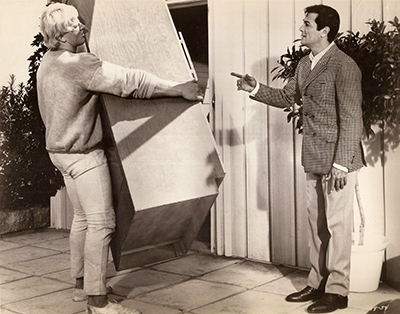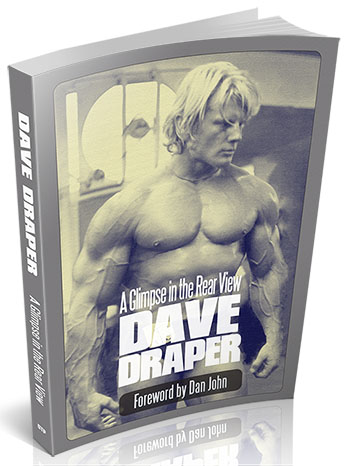What Do You Want to Accomplish?

Download the full Draper here newsletter
in printable, live-link, pdf format, here.
I thought because I was a hardcore professional with the sand of Muscle Beach under his fingernails and the stripes of the Dungeon dwelling across his back, visitors of davedraper.com would be a gnarly mob with their own brand of iron wear and tear. We're bombers, after all. Not so, Joe. Think again, Ben.
It seems there are more untested, runway-bound bombers wandering our pages, reading the newsletter, lurking the forum and sending emails than you can rattle a plate at. To many, designing a routine is rocket science, implementing it is like crossing the Alps on a goat.
They're not dumb. Obviously, they've come to the right place for the right reasons. For most, it has been a while since they exerted themselves -- high school or college, before marriage, kids, job and assorted bulges. They just need a little direction and encouragement.
Considering this startling observation, a few basic training principles might be in order for the rusty and out-of-touch, the clueless and ill-informed, the tired and wasted. Let's take a look -- we'll all benefit. It's good to return to the faded dog-eared pages of a training log to rediscover and uncover, to remind and recall. We find truth, wonder and creativity in faded memories.
The most direct way to build muscle and strength is to lift weights consistently and hard. That's rule number one. It's wise to have a simple plan and execute it consistently and hard. That's rule number two.
How basic can we get?
Two rules: lift weights and have a plan.
Two precepts: work hard and be consistent.
Designing a plan -- routine, workout, program, scheme, methodology -- is not rocket science as presumed by some; in the early stages of training, it's a notch above a no-brainer. Let's face it, if this pursuit took brains, I'd have spent my life picking up trash on the interstate.
Begin by asking yourself the following fundamental questions:
What do I know about training -- zero, vaguely familiar, intermediate level, former trainee?
What do I want to accomplish? What are my goals?
How much of myself am I willing to invest: time, resources and energy?
Where, when and with what will I exercise?
Finally, will I? Or is this where the little experiment ends?
More questions will arise now that you've initiated the conversation. Some will be tough, some silly. They'll be bound in the mind and body, the heart and the soul. They will perplex you, frustrate you and drive you up a wall. Be strong. The answers will lead you to success and fulfillment, or bowling, beer and the couch.
Step one: Imagine the body as a collection of separate yet inter-related bodyparts or muscle groups. They are the chest region, the back, shoulders, biceps, triceps, midsection and legs.
Step two: For each muscle group there are relatively specific exercises for their development.
Side note: No exercise recruits one muscle without engaging closely associated and attached muscles. Here's where we exercise our commonsense, as well as our sinew. Muscles and systems of muscles are connected. This is cool to know, encouraging and technically important. We're getting more pump and burn for every set and rep we perform.
Step three: Determine and list the various simple exercises for the various groups by inventing, inquiring, reading or observing.
Step four: Choose one or more exercises from the lists to design a routine to match your needs -- your goals, purposes and ambitions, desires and level of development.
I've got an idea (jaws drop, lightening flashes, thunder rumbles). Since I'm already in the pilot's seat and have my hands on the controls, I'll piece together an assortment of workouts of diverse levels and present comments along the way.
No equipment? FEW is for you (Freehand Exercise Works).
Freehand pushups, dips and chins, running and crunches are hard to beat for building an entire body. They are simple and healthy, and can be practiced and developed right here, right now with no equipment and a little resourcefulness.
Raw, free-style training is instructive, insightful, demanding and friendly. It encourages improvisation, stimulates the instincts, pumps and burns the muscles, shapes them and strengthens them and brings you close to the action.
These movements get you going, take you there, and keep you there.
At first, play -- push, pull, experiment, stretch, strain, entertain -- with the freehand moves to get to know them, the form, the degrees of exertion, what muscles are involved, where you are strong and where you are weak, and uncover any perceived injuries or limitations. This testing and inspecting will prepare and strengthen your muscles and insertions, familiarize you with the concept of routine training, provide comfort and confidence in your pursuit and excite discipline.
Freehand exercise, smart eating and right living makes strong men and women of feeble girls and boys.
Got iron? Let's move on then. Here's one of my favorite standards for the early trainee. You've seen it before; it must be good. I like the scheme because it worked for me (and Arnold and Zane and Franco and Katz and Sergio and Lee and Zabo and Reeves and Cutler) when time was short, I was unfocused, on the road or between solid workout regimens. It's complete, smoothly overlaps muscle groups, and has muscle appeal, push-pull rhythm and pump-burn excitement.
Three alternate days a week with aerobic and midsection when you please (which doesn't mean never):
Musclebuilder 101-A
> Dumbbell press -- Chest and associated muscles (front delt, triceps, related upper body mass)
> Widegrip pulldown -- Lats and associated muscles (biceps, minor pec, related upper body mass)
> Standing barbell curl -- Biceps, forearm and grip (plus whole-body musculature -- including midsection and legs -- assisting the minor thrusting action and body-stabilization)
> Freehand or machine dips -- Triceps, pecs, deltoids, upper back and abs
> Walking Lunges -- Legs
Sets and reps depend on the lifter's status:
One set of 10 reps for the total beginner
Two sets of 10 reps for the same lifter in 4 to 6 workouts
Three sets of 8-10 reps in a month
Four or five sets of reps of choice for bombers when the need arises
Look out for low-flying objects, bombers. Crash landings are not uncommon this time of year -- easing into shorter days, colder temperatures, holidays on the horizon, sniffles, the lure of the fireplace and hot toddies.
Take your time before it's too late...
Go... Godspeed... Dave
*****
Take a trip over to our
Musclebuilding Q&A Blog
... where Dave allows us a peek into his email outbox.
Did you sign up for Dave's expanded email yet?
It's free, motivating and priceless!
We'll also send you a link to Dave's free
Body Revival Tips and Hints e-report with your confirmation notice.

